Categories: Beauty & Style, Breastfeeding, Parenting, Self-care
May 19, 2021
You’ve just had your little one. Congratulations! Even if your baby isn’t on any kind of schedule, you are itching to get back into some sort of exercise routine. Maybe you are still waiting for the big day, trying to understand how to get back into the swing of things after baby. You find yourself asking, “When can I start working out? What exercises are safe after pregnancy? Where exactly do I start?”
Your body, mind, and breastfeeding with exercise
Benefits of Exercise
Working out is more than just losing the baby weight. It can help you start to get back to a sense of normalcy, gives you some much needed “me” time, and sets a great example for any older children you have. Getting back into a consistent workout routine also provides a number of both physical and mental benefits, which are crucial for moms recovering from childbirth.
When your caregiver gives you the approval to introduce exercise back into your routine, you’ll likely begin to see the following benefits:
- Reduced symptoms of postpartum depression and baby blues
- Relieved stress
- Improved sleep
- Boosted energy levels
- Healthy weight loss
- Increased cardiovascular health
- Strengthened and toned muscles, helping abdominal area return to pre-baby state
Exercise and Breastfeeding
Many breastfeeding moms are concerned how exercise will affect their milk supply. The short answer is, it won’t. Kellymom.com, an International Board-Certified Lactation Consultant and trusted resource for breastfeeding moms, provides some peace of mind. Studies have found no difference in milk production or nutrient composition when moms exercise regularly. Contrary to popular thinking in the 90’s, there is also no indication from recent studies that suggest babies reject milk after mom works out, whether the exercise is moderate or exhaustive (high intensity). Moms can feel confident that exercising will not negatively impact their breastfeeding efforts.
When to start?
First, it’s important to get approval from your doctor before you begin any sort of exercise regimen after baby. In many cases, providers, including the American College of Obstetricians and Gynecologists, agree it is okay for women who have had an uncomplicated, vaginal birth to engage in certain exercises as soon as a couple of days after delivery. This guidance may change if there were complications or a c-section. Before you are discharged from the hospital you can ask the attending physician when you can start working out again, or you can call your OBGYN to get clarification before your return visit. Once you get the go ahead from your doctor, you can start to work on the exercises below.
Exercises
Kegels – Locate your pelvic floor muscles. Pretend you are stopping the flow of urine or tightening up against a tampon. Contract and release a few times to become aware of these muscles. Now that you have located them, tighten them for 5 – 10 seconds. Relax them. Repeat. For added variation and effectiveness, you could use the award-winning Elvie Trainer, a device that connects to an app on your phone and guides you through targeted exercises with trackable results.
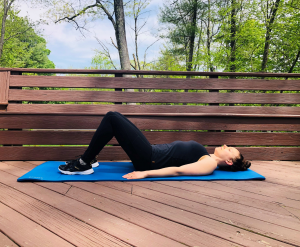
Pelvic tilts – Lie on your back with your knees bent, feet flat on the floor, and your arms at your sides. Inhale, on the exhale draw your abs in and tuck your pelvis under slightly. To add even more intention to this move, do a kegel while you tuck your pelvis in. Hold for 5 – 10 seconds. Release and repeat.
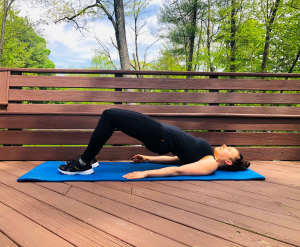
Glute bridges – Lie on your back with your knees bent, feet flat on the floor hip-width apart. Inhale, on the exhale draw your hips and abs up, lifting your hips off the floor into a bridge, hips and back in a straight line. Squeeze your glutes as if you are pinching a penny between your butt cheeks. Release to the floor and repeat.

Heal slides – Lie on your back with your knees bent, feet flat on the floor hip-width apart. Draw your abs into the spine. Inhale and flex one of your feet. As you exhale, slowly push your flexed heel away from your body until your leg is extended, engaging your deep abdominal muscles. On the inhale, return to starting position, using your deep abdominal muscles to bring your leg back in. Alternate sides.
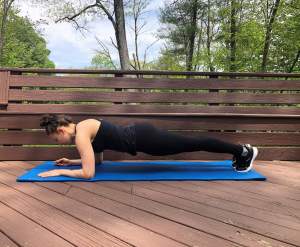
Forearm planks – As you start to regain core strength, you can progress to more intensive abdominal exercises such as different plank variations. Lie face down on the floor with your elbows directly beneath your shoulders, forearms in front, and palms on the floor. Tighten your abs as you raise your legs and core off the ground, keeping neck, core, and legs in a straight line. Modify by keeping your knees on the ground. Hold for 30 – 60 seconds. Repeat.
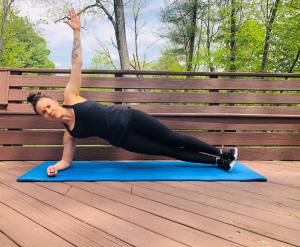
Side planks – Slightly more advanced than the forearm plank, is the side plank. From a forearm plank, shift your weight to one elbow, place your other hand on your hip, or point it up towards the sky. Stack your feet. Lift your hips so your neck, back, and legs are in a straight line. To modify, put the bottom knee on the ground. Hold for 30 – 60 seconds. Repeat.
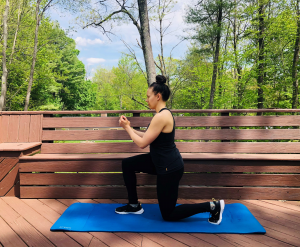
Forward lunges – From a standing position, take a long step forward. Lower your back knee to the floor. Keep your front leg at a 90-degree angle, making sure your knee doesn’t go past your toes and the weight is in the heel of your front leg. Raise back up. Stay on one side or alternate between sides to increase balance and cardio.
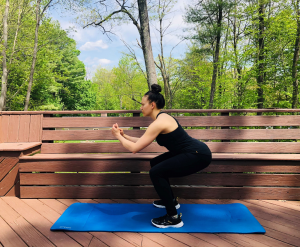
Squats – Stand with your feet hip-width apart. Lower your butt as if you are going to sit in a chair, keeping your knees behind the toes. As you lower, keep the weight backwards through your glutes and draw your pelvic muscles in, doing a kegel. Come back up to standing position, push your glutes forward and squeeze your lower abs. Repeat.

Seated and standing marches – Sit at the edge of a chair with your feet hip-width apart, back tall, and spine straight. Lean back enough so you feel your core engage but not too far that your spine is no longer in a straight line. On the exhale, slowly bring one foot off the floor a few inches, hold, then release back to the floor. Alternate sides. Progress to standing marches.
Cardio – Strength training will help you regain muscle, tone, and increase balance. Cardio will help you lose the extra weight gained during pregnancy. There are many ways to get cardio in. Dance, swim, do a kickboxing routine, jump on an indoor cycle or go for a bike ride, use a rowing machine, put your baby in the stroller and go for a walk or light jog. The important thing is to get moving and get your heart rate up.
Things to keep in mind
- Get approval from your caregiver to begin an exercise routine
- Warm up and cool down
- Progress slowly but steadily
- Nurse or pump before working out for comfort
- Wear a supportive bra
- Stay hydrated
- Stop if you feel pain, start bleeding, or leak fluid
- Your balance may be off while you are breastfeeding or pumping
A note on Diastasis Recti
Abdominal separation, also known as diastasis recti, is when the right and left sides of the abs or “six-pack” muscles widen and no longer connect. As one of the main contributors to the “mummy tummy”, it’s important to identify and correct diastasis recti. Certain exercises such as sit-ups and crunches can actually increase the separation, having the opposite effect of flattening the tummy area. For more information on how to diagnose and correct diastasis recti, read “Diastasis Recti in Pregnancy: Ab Separation Cause & Treatment” from What to Expect, talk to your healthcare provider, or a personal trainer.
Remember, your body just went through the amazing process of growing and giving birth to a baby. Give yourself, your body, and your baby time and grace.

